Input interpretation

methyl propyl ketone
Chemical names and formulas

formula | CH_3COCH_2CH_2CH_3 Hill formula | C_5H_10O name | methyl propyl ketone IUPAC name | pentan-2-one alternate names | 2-pentanone | ethyl acetone | pentan-2-one mass fractions | C (carbon) 69.7% | H (hydrogen) 11.7% | O (oxygen) 18.6%
Lewis structure
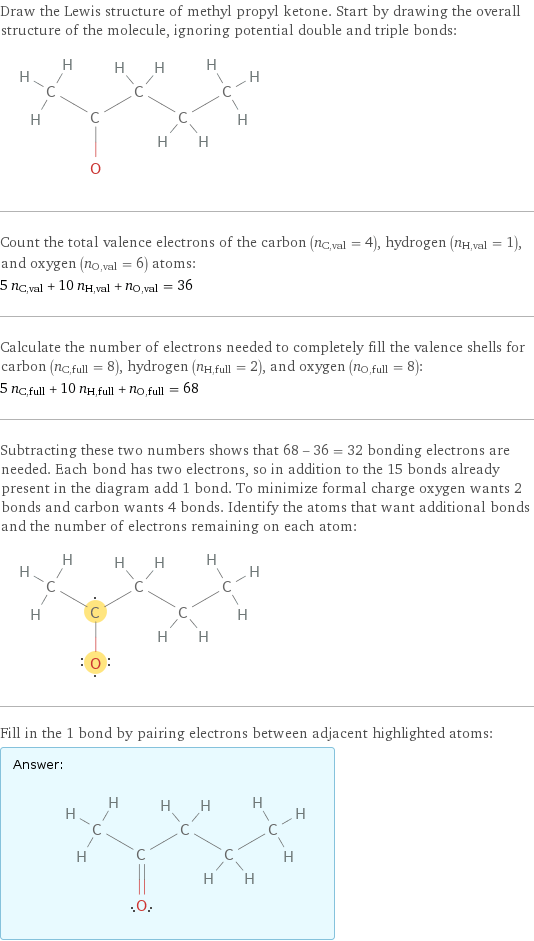
Draw the Lewis structure of methyl propyl ketone. Start by drawing the overall structure of the molecule, ignoring potential double and triple bonds: Count the total valence electrons of the carbon (n_C, val = 4), hydrogen (n_H, val = 1), and oxygen (n_O, val = 6) atoms: 5 n_C, val + 10 n_H, val + n_O, val = 36 Calculate the number of electrons needed to completely fill the valence shells for carbon (n_C, full = 8), hydrogen (n_H, full = 2), and oxygen (n_O, full = 8): 5 n_C, full + 10 n_H, full + n_O, full = 68 Subtracting these two numbers shows that 68 - 36 = 32 bonding electrons are needed. Each bond has two electrons, so in addition to the 15 bonds already present in the diagram add 1 bond. To minimize formal charge oxygen wants 2 bonds and carbon wants 4 bonds. Identify the atoms that want additional bonds and the number of electrons remaining on each atom: Fill in the 1 bond by pairing electrons between adjacent highlighted atoms: Answer: | |
3D structure
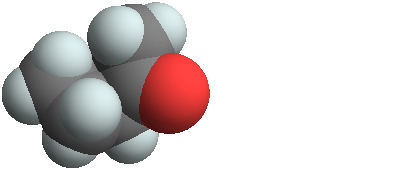
3D structure
Basic properties

molar mass | 86.13 g/mol phase | liquid (at STP) melting point | -78 °C boiling point | 103 °C density | 0.809 g/cm^3 dielectric constant | 13.6
Liquid properties (at STP)
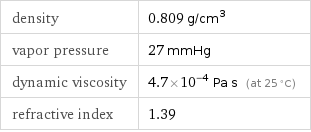
density | 0.809 g/cm^3 vapor pressure | 27 mmHg dynamic viscosity | 4.7×10^-4 Pa s (at 25 °C) refractive index | 1.39
Units

Thermodynamic properties

specific heat capacity c_p | liquid | 2.137 J/(g K) molar heat capacity c_p | liquid | 184.1 J/(mol K) specific heat of formation Δ_fH° | gas | -3.005 kJ/g molar heat of formation Δ_fH° | gas | -258.8 kJ/mol molar heat of vaporization | 38.4 kJ/mol | specific heat of vaporization | 0.446 kJ/g | molar heat of combustion | 3099 kJ/mol | specific heat of combustion | 35.98 kJ/g | molar heat of fusion | 10.63 kJ/mol | specific heat of fusion | 0.1234 kJ/g | critical temperature | 561 K | critical pressure | 3.672 MPa | (at STP)
Chemical identifiers
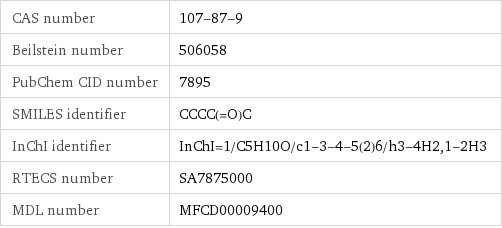
CAS number | 107-87-9 Beilstein number | 506058 PubChem CID number | 7895 SMILES identifier | CCCC(=O)C InChI identifier | InChI=1/C5H10O/c1-3-4-5(2)6/h3-4H2, 1-2H3 RTECS number | SA7875000 MDL number | MFCD00009400
NFPA label

NFPA label
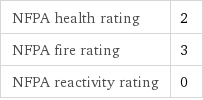
NFPA health rating | 2 NFPA fire rating | 3 NFPA reactivity rating | 0
Safety properties
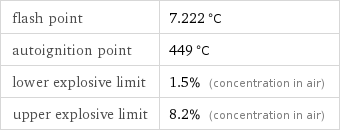
flash point | 7.222 °C autoignition point | 449 °C lower explosive limit | 1.5% (concentration in air) upper explosive limit | 8.2% (concentration in air)